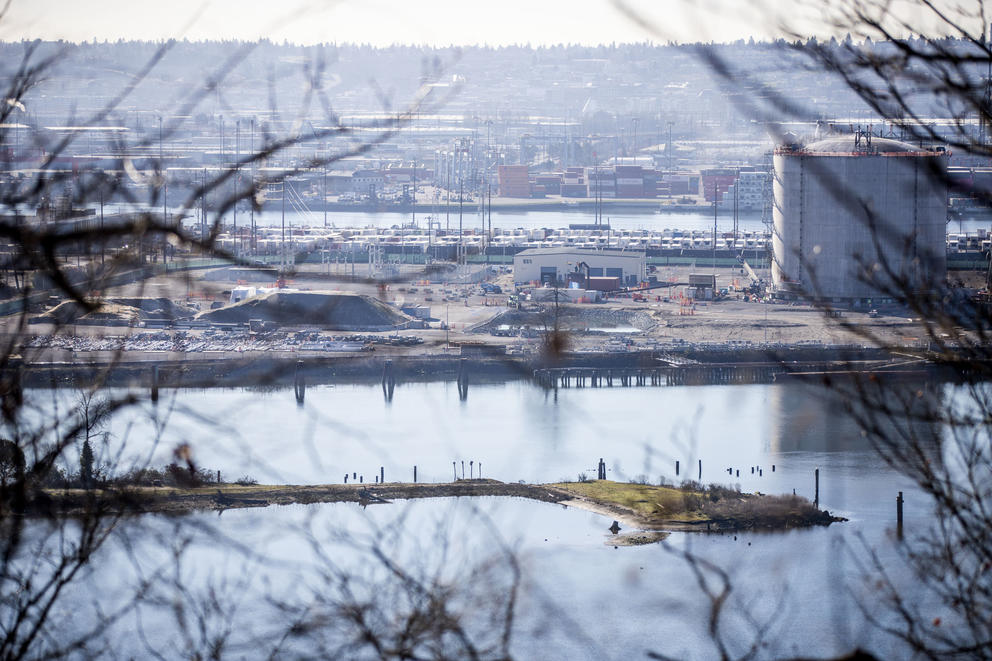As a Puyallup tribe member, Bryan shared their worries: Puget Sound Energy (PSE) plans to build the LNG project on the Tideflats, an area of ancestral lands for the Puyallup tribe “since time immemorial.” As a former tribal coordinator at the Environmental Protection Agency with a degree in civil and environmental engineering, she was also worried about the facility's physical impacts, which includes increased risks of air pollution and water contamination.
“There’s a philosophy about the tribe and how we love the fish and love the earth — that’s deep within our bones,” Bryan says. But she says that beyond honoring the land of her ancestors, there’s a scientific argument against the LNG project as well.
“I also believe very strongly in the faults that are found in the technical scientific data,” she says. “That’s where I’d like to see some more information.”
Bryan — now a Puyallup Tribal Council member — joined those local activists after learning more, helping to build what’s now become a wider rallying cry against the facility’s development. Tensions rose even more when PSE first issued an environmental impact statement in November 2015 that many stakeholders found lacking. Criticism now comes from many sources, including environmental groups, public officials and residents of the area surrounding the LNG project’s location.
In response to those concerns, the Puget Sound Clean Air Agency (PSCAA) was asked to create a supplemental environmental impact statement (SEIS). When the PSCAA released a draft of that statement in October, the community responded in overwhelming fashion.
Although PSCAA Director of Compliance Steve Van Slyke isn't certain of the exact number, he says his agency received “over 10,000” comments. The PSCAA now has to sort them and respond to the questions they contain. With so many respondents, a final SEIS planned for February has now been delayed until March 29.
While an SEIS is still part of the PSCAA’s plan, both supporters and opponents can only wait to hear if the protests had any impact on the assessment. “We haven’t made any final decisions," Van Slyke says. "We’re processing information and considering what we heard.”
In the meantime, the LNG project itself remains under construction (which started in 2016). If completed by its expected date in 2020, it would hold 8 million gallons of natural gas piped in from British Columbia, which then gets frozen into liquid onsite for storage in and distribution from Tacoma.
Puget Sound Energy says the LNG facility would both provide a “cleaner fuel alternative” to fuels currently dirtied up with things like sulfur, and offer natural gas reserves for customers “to maintain dependable service on the coldest days of the year.” The gas would also be used to fuel maritime transportation between Alaska and Tacoma for vessels like those operated by TOTE Maritime Alaska, a domestic shipping company.
Beyond intrusion into Puyallup ancestral grounds, the project has been criticized for how close it is to a residential area.
“It’s located smack dab in an urban industrial area, which is generally not a good idea because liquified natural gas is inherently risky,” says Eric de Place, programs director with the Sightline Institute. He adds that he hasn’t seen any similar projects proposed in urban industrial areas before. There are more than 110 LNG facilities currently in operation around the U.S., many located offshore or miles away from cities.
Since getting elected to the Puyallup Tribal Council in 2016, Bryan has worked to bring continued attention to the facility. The tribe had already been disappointed by the consultation process with Tacoma government and began to worry about the project's effects on surrounding wildlife. Tribal members asked for plant permits to be halted in 2015. Bryan says that the tribe’s ongoing litigation and her newfound status on the council made it initially more difficult to speak publicly about the issue. But she has always sensed a need to attract attention, and that need is growing by the day.
“None of the people around it want it here,” she says. “So I hope that the city of Tacoma will open up their ears and listen to the outcries of the public that they serve.”
With the delayed SEIS, Bryan says that she’s cautiously optimistic about the future of the Tideflats. Looking at the large number of complaints during the comment period, she says that should be enough “to alert the decision makers that this may not be a good idea.”
“I’m going to rely on the science and not my emotions here,” she says. “And I think that’s what we all need to be doing — [we need to] really look at this facility and where it’s sited and [decide] whether or not it’s a good fit for our community.”



